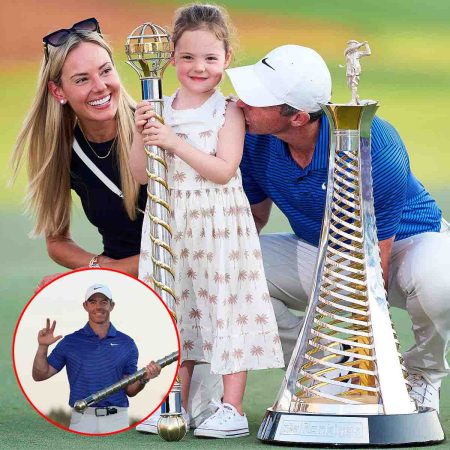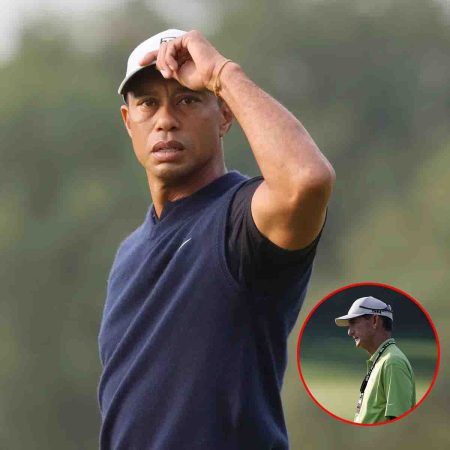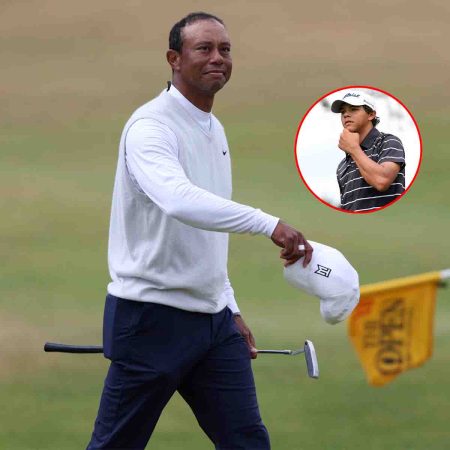Karim Benzema is coming into form at just the right time for Real Madrid.
The French striker sent a warning shot to Madrid’s next opponents with his six-and-a-half-minute hat-trick against Real Valladolid on Sunday. Carlo Ancelotti’s side will look to him again as they aim to overturn a 1-0 deficit in the Copa del Rey semi-finals against Barcelona on Wednesday night, before the first leg of their Champions League quarter-final tie against Chelsea next week.
Benzema has become Madrid’s leader since Cristiano Ronaldo left for Juventus in 2018. He scored a career-best 44 goals in 46 games last season to help Real to a La Liga-Champions League double, capping off last year with a first Ballon d’Or win in October. The 35-year-old is the club’s second all-time top scorer, with 345 goals in 635 games, behind Ronaldo (450 goals in 438 appearances).
Much of that is down to Benzema’s physical and mental transformation since he joined Madrid in 2009 — something that surprised Ancelotti when he returned for his second spell in charge in 2021. The Frenchman’s rippling physique has been crafted through hours of work in the gym and with one man in particular: his friend and personal trainer Javier Atalaya.
Karim Benzema: The making of a world-class No 9
Atalaya is a former karate expert who began working with Benzema eight years ago on the recommendation of a mutual friend. He quickly connected with the striker and convinced him of his methods for off-the-pitch success — which include a body suit inspired by the Rocky films, mysterious slogans and plenty of strenuous exercises.
We decided to try it out for ourselves by visiting Atalaya’s gym. So, could this writer keep up with Benzema?
Atalaya’s system is based on an electrostimulation suit that causes muscular contractions. Benzema’s routine is intense: half an hour with the personal trainer is the equivalent of five hours in a normal gym, according to Atalaya, while the striker directly works 92 per cent of muscles in the body at the same time with each exercise.
The trainer also plays a key role in Benzema’s nutrition. The forward has a personal chef at home, but he consults Atalaya on what he should eat every day. His diet is heavy on sushi, proteins and pasta, but he avoids foods with too much fat.
The Frenchman is observing Ramadan as a practising Muslim; he eats before sunrise and does not eat or drink anything until after sunset, when he breaks his fast with dates and milk. On Sunday, the cameras captured him spitting out water on the bench after he came off in the second half — Muslims are not even allowed to drink water during daylight fasting hours.
Being a footballer during Ramadan
Benzema is not the only high-profile client Atalaya has seen. He has worked with actors, company directors and other footballers including Cristiano Ronaldo — Atalaya trained the Portugal star for a year before Benzema, but he preferred exercises with greater mobility and left because “it didn’t suit him”.
Atalaya’s gym, Body Extreme, is based in the heart of Madrid. It is 30C (86F) when he welcomes The Athletic in and explains where the body suits come from.
“Do you know who started this?” he asks. “Do you remember the film Rocky IV? Ivan Drago.”
 Karim Benzema and The Athletic’s Guillermo Rai pose with the striker’s personal trainer Javier Atalaya (Photos: Karim Benzema, Guillermo Rai/The Athletic; designed by Eamonn Dalton).
Karim Benzema and The Athletic’s Guillermo Rai pose with the striker’s personal trainer Javier Atalaya (Photos: Karim Benzema, Guillermo Rai/The Athletic; designed by Eamonn Dalton).
Atalaya’s hair is dyed platinum blond, but what stands out most is his physique. He says he hasn’t trained for two months, but he looks incredibly sturdy for a middle-aged man.
“Look, touch here, and here,” he says, pointing to his biceps and calf, which feel like rocks. “That’s thanks to the suit, and I haven’t worn it in a while,” he adds, grinning from ear to ear as he gets the black suit ready.
“Well, I’m stringy,” I reply, so as not to get his hopes up. “We’ll see,” he says.
There is no turning back. It is not Morgan Freeman or Michael Caine preparing the Dark Knight’s high-tech suit, but Atalaya makes this 24-year-old reporter — who goes to the gym three times a week with little motivation and was top of his athletics class at school — feel like Bruce Wayne on his way to save Gotham yet again.
According to Atalaya, the suit costs around €30,000 (£26,000, $33,000) and weighs less than three kilograms, depending on how much water is sprayed into it. “You have to spray water into it so that it conducts the energy through the body, otherwise it’s useless,” he says, taking time to make sure the suit is completely wet.
Apart from this expensive invention, clients wear leggings and a tight-fitting thermal t-shirt — the lighter the better. That can regularly be seen in Benzema’s weekly Instagram stories, where he appears alongside his friend Atalaya with slogans such as “oscuridad total” (total darkness) or “vamos” (let’s go).
“The slogans are invented by us because we are dark, impenetrable. We are the dark side,” Atalaya explains.
“More players call me — last week, it was Rodrigo De Paul from Atletico Madrid — but now I stay only with Karim because of friendship. It’s total darkness, we’re together for everything.”
Atalaya is the only person specialised in these electrostimulation suits who is allowed to train Madrid’s players. Benzema normally trains for two sessions a week with him. “One (session) two or three days before the game, which is muscular exercise and resistance,” he explains, “and another the day after the game, which is recovery for the muscle fibres that are broken.”
First things first, Benzema always dedicates 15-20 minutes to cardio, for which he tends to use an elliptical machine or a treadmill with steps. He never uses a traditional treadmill. “The treadmill weakens the knee because of the impact,” Atalaya warns, as he starts up the suit while I take my first steps on the elliptical.
Suddenly, a tingling sensation runs from my left shoulder all the way down to my right knee. The machine has not even reached 12 per cent of its full power yet but it has already taken my breath away as I continue to push.
“Can I give you a little more power?” Atalaya asks. “Come on, let’s go with 15 per cent.” This exercise is designed to burn calories and tone up at the same time.
Ten minutes have passed when a pain in my badly bruised left shoulder forces me to lower the suit’s intensity in that part of my body. But Benzema’s trainer does not want me to slack off and increases the power across the rest of my body.
I am feeling more and more motivated as my endorphins start to kick in. I move on to the next exercise on Benzema’s list: squats, one of the Frenchman’s favourites, as he loves to exercise his hamstrings and quadriceps, along with his impressive abdominals.
The trick is not to damage your knees by bringing the body too far forward, while pulling on a rubber band as if rowing while the suit works on the remaining muscles. I am only lifting 15 kilograms, but it is hard work. I grit my teeth and try not to think about how Benzema lifts almost three times as much as me, reminding myself that the striker weighs 81 kilograms, 17 more than me.
“We changed training when we switched from the XBody suit to the I-Motion, which is the best on the market and does not displace any metal or titanium prosthesis,” Atalaya says. “At the beginning, the objective (with Benzema) was to burn and tone up. We had to lose volume to gain speed and endurance because you can’t put too much muscle mass on a football player.
“His body has changed. He’s a bull. He trains like a 24- or 25-year-old. Now what we do with Karim is to strengthen him, to give him depth. Look at the PSG game (when Benzema’s hat-trick helped Madrid complete a remarkable comeback in the Champions League last 16 last season): after 90 minutes, he’s still running while the rest are cramping up, which is normal, but with these sessions, Karim has gained more strength.”
It is time for the next biceps exercise, which I complete without any problems after three sets of 15 repetitions. I have grown used to the suit by now, but Atalaya raises the overall intensity to 20 per cent and it shows. “Karim does the exercises with an intensity between 50 and 60 per cent,” the personal trainer says.
We start the series of abdominal exercises, which Atalaya says are Benzema’s favourite part of the routine. I rest my back on a giant rubber ball and complete another two sets without much difficulty. Like the Ballon d’Or holder, it seems to be the exercise I am best at. But why so much focus on the upper body for an athlete who relies on his legs?
“Now that Benzema trains it so much, he tells me: ‘Bro, there is no defender who moves me when I jump in the box’,” Atalaya says.
 Guillermo is put through his paces by Benzema’s personal trainer (Photos: Guillermo Rai/The Athletic; designed by Eamonn Dalton).
Guillermo is put through his paces by Benzema’s personal trainer (Photos: Guillermo Rai/The Athletic; designed by Eamonn Dalton).
That was clear for the last goal of Benzema’s hat-trick on Sunday, when the striker produced an acrobatic finish with his back turned to goal. But Atalaya says his sessions have not changed Benzema’s style.
“His game hasn’t changed with me, it’s just that he can do more things because he has more stamina, he jumps in the box and nobody is able to move him,” he says. “He also has more flexibility. He likes martial arts, he used to have a boxing trainer and sometimes he does kickboxing with me, but always with a suit on.”
After 25 minutes, there is only one exercise left. This involves kneeling on a mat and stretching with a wheel until you are parallel to the ground. I was feeling invincible, but this was undoubtedly the most painful of the exercises. After two sets of 10 repetitions, I give up — but at least I receive some faint praise from Atalaya.
“You’re not the worst journalist I’ve ever had,” Atalaya says. Just as with Benzema, he leaves the suit on me for 10 more minutes so I can use the massage and drainage function, which are essential for treating injuries.
“Karim was once caught between Luka Modric and Toni Kroos (in a training ground collision),” Atalaya adds. “He said to me: ‘Bro, we’re not training today’. His quadriceps were swollen, I told him to relax and I went over there. I put the suit on him for 20 minutes to let it drain and he recovered the broken muscle fibres.
“He has more injuries now but they are muscular, not big injuries.”
Atalaya usually recommends at least 48 hours of rest between high-intensity sessions. It is even better if his clients can take 72 hours to recover, as is usually the case with Benzema.
It is time to take my suit off after our 35-minute session. After 15-20 minutes of cardio, five sets of 15 working on my abdominals and three of 15 on my arms, I feel energised, but Atalaya brings me back down to earth.
“Tomorrow and especially the day after tomorrow, you’re going to have some serious stiffness,” he says.
Three days later, Atalaya’s words are still echoing in my head as I write this article. The stiffness remains, but it does not take away from my sense of accomplishment. Who knows: perhaps I could even play in El Clasico on Wednesday night.
src:








